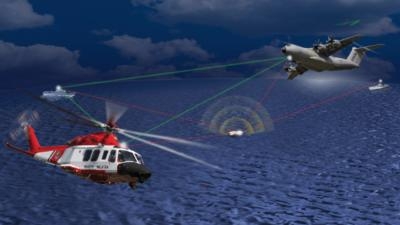Sat, Aug 08, 2015
Advanced Direction Finding Capabilities May Lead To Shorter Searches And Faster Rescues
Building on the search and rescue (SAR) mission success of its predecessor, Rockwell Collins has introduced its new DF-500 Direction Finder.

The highly capable DF-500 system pinpoints distress signals with unmatched accuracy and reliability. It enables aircraft to receive and immediately locate activated 406 MHz Emergency Position-Indicating Radio Beacon (EPIRB) signals, allowing crews to go directly to people in distress.
“When it comes to airborne SAR missions, saving time is often the difference between a rescue and a recovery,” said Troy Brunk, vice president and general manager, Airborne Solutions for Rockwell Collins. “That's why civilian, government and military SAR organizations are upgrading their aircraft’s direction-finder capabilities with Rockwell Collins’ DF-500 direction finder.”
The next generation DF-500 direction finder replaces the DF-430, which serves government and military SAR operators in all domains worldwide. The DF-500 is fully backwards compatible with the DF-430 direction finding system. Additionally, the system’s all solid-state antenna is designed to easily drop into mounting provisions for the widely used DF-301E direction finding antenna system.
Software defined radio technology developed for the DF-500 enables higher sensitivity, immunity to interferences, and stability of bearing indications. New features include multi-channel scanning and real-time monitoring, as well as fast scanning and interoperability with maritime digital selective calling (DSC) and automatic identification system (AIS) distress protocols. Its unique multi-channel architecture enables key frequencies to be monitored simultaneously allowing rapid detection of emergency beacons and distress or safety calls over V/UHF radios.
The DF-500 provides full compatibility with all existing and all future identified frequencies for the International COSPAS-SARSAT Program, a satellite-based SAR distress alert detection and information distribution system, and can be upgraded to new waveforms.
(Image provided by Rockwell Collins)
More News
The Airplane Made An Uncommanded Right Yaw And Roll, And He Was Unable To Maintain Control Of The Airplane On November 11, 2025, about 1750 central standard time, a Cirrus SR20, N8>[...]
Aero Linx: Florida Antique Biplane Association "Biplanes.....outrageous fun since 1903." That quote really defines what the Florida Antique Biplane Association (FABA) is all about.>[...]
Wind Shear Escape An unplanned abortive maneuver initiated by the pilot in command (PIC) as a result of onboard cockpit systems. Wind shear escapes are characterized by maximum thr>[...]
“Working closely with the Polish Armed Forces, we’re focused on disciplined execution to help enhance Poland’s defense capabilities and keep up with the strong de>[...]
Also: Bell 505 on SAF, NYPA Gets Flak For BizAv 'Abuse', FAA Venezuela Caution, Horizon Update Textron Aviation has confirmed it will be ending production of the Beechcraft Bonanza>[...]
 NTSB Prelim: Cirrus Design Corp SR20
NTSB Prelim: Cirrus Design Corp SR20 ANN's Daily Aero-Linx (11.30.25)
ANN's Daily Aero-Linx (11.30.25) ANN's Daily Aero-Term (11.30.25): Wind Shear Escape
ANN's Daily Aero-Term (11.30.25): Wind Shear Escape Aero-News: Quote of the Day (11.30.25)
Aero-News: Quote of the Day (11.30.25) Airborne 11.26.25: Bonanza-Baron Fini, Archer v LA NIMBYs, Gogo Loses$$$
Airborne 11.26.25: Bonanza-Baron Fini, Archer v LA NIMBYs, Gogo Loses$$$



